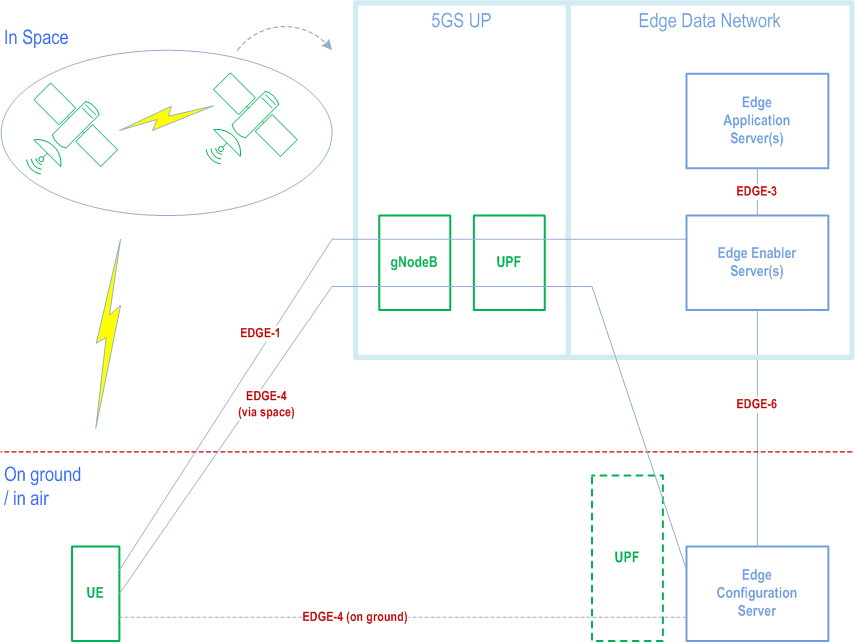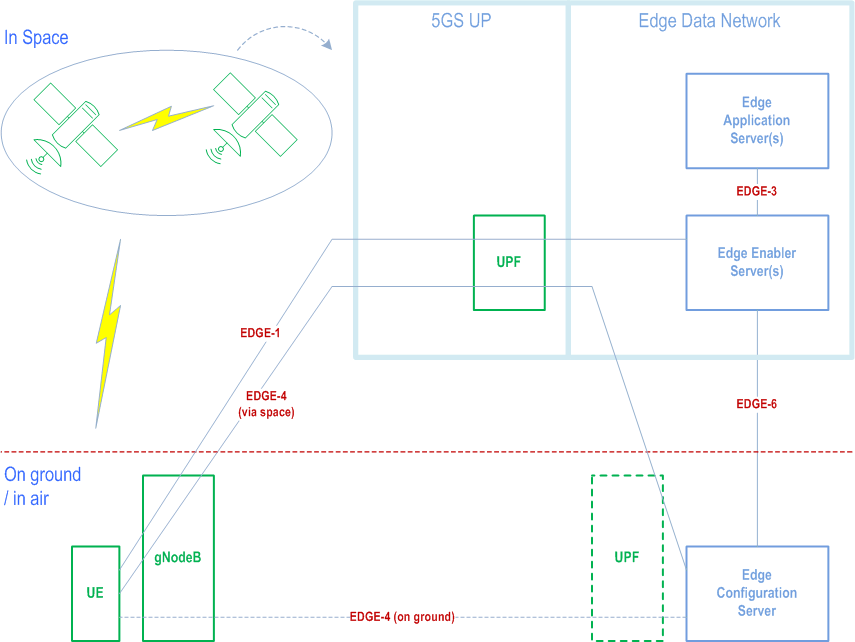Content for TS 23.558 Word version: 19.4.0
0…
5…
6…
6.2a…
6.2b…
6.3…
6.4…
7…
8…
8.3…
8.3.3…
8.3.3.3…
8.4…
8.4.3…
8.4.4…
8.5…
8.6…
8.6.3…
8.6.4…
8.6.6…
8.7…
8.8…
8.8.2.5…
8.8.2A…
8.8.3…
8.8.4…
8.8.5…
8.9…
8.14…
8.14.3…
8.15…
8.17…
8.17.3…
8.17.4…
8.18…
8.19…
8.20…
9…
A…
A.4…
A.5…
B…
E…
A Deployment models
A.1 General
A.2 Deployment models for different DN implementations
A.2.1 General
A.2.2 Option 1. Use of non-dedicated DN
A.2.3 Option 2. Use of Edge-dedicated DN
A.2.4 Option 3. Use of LADN
A.2.5 Option 4. EDN in GEO/MEO/LEO satellite
A.3 ECS deployments in relation to the UE
A.3.1 General
A.3.2 UE (EEC) served by a single ECS
A.3.3 UE (EECs) served by multiple ECSs
...
...
A Deployment models p. 295
A.1 General p. 295
The following clauses illustrate different aspects of some possible deployment options
- Clause A.2 describes some deployment models for different DN implementations;
- Clause A.3 describes some options for how ECS is deployed in relation to the UE;
- Clause A.4 describes deployment of EES in relation with SEAL services and Application Enabler Services; and
- Clause A.5 describes deployments in relation with CAPIF.
A.2 Deployment models for different DN implementations p. 295
A.2.1 General p. 295
This clause describes examples of deployment models with respect to different DN implementations as follows:
- option 1: use of non-dedicated DN;
- option 2: use of Edge-dedicated DN; and
- option 3: use of LADN.
- option 4: EDN with EAS and EES in GEO/MEO/LEO satellite.
A.2.2 Option 1. Use of non-dedicated DN p. 295
There is no Edge-dedicated DN for support of edge computing service. A DN common to other services (e.g. internet access) is used to connect to the EASs.
The PLMN supporting edge computing services provides connection to EASs located in EDNs that respectively corresponds to one or more DNAI(s), and each EDN is identified by DNN and one or more DNAI. UEs establishing PDU sessions for the EASs identify the DN using the same DNN and slice information as for PDU sessions for non-Edge services.
Each EAS and EES can have a topological service area or a geographical service area that the EAS and EES serves, respectively. Within this service area, UEs can access an EAS or an EES regardless of their location within the PLMN area via local breakout.

A.2.3 Option 2. Use of Edge-dedicated DN p. 296
The deployment uses Edge-dedicated DNs for support of edge computing service. Each Edge-dedicated DN is configured with unique DNNs.
The PLMN supporting edge computing services provides connection to several EDNs that correspond to one or more DNAI(s), and each EDN is identified by DNN of the Edge-dedicated DN and one or more DNAI.

A.2.4 Option 3. Use of LADN p. 296
Edge computing services can be provided via Edge-dedicated Data Networks deployed as LADNs. With this option, the PLMN supports edge computing services in the EDN service areas which is equal to the LADN service area. The LADN service area is the service area that the Edge Computing is supported. Each individual EAS in the LADN can support the same or smaller service area than the LADN.

A.2.5 Option 4. EDN in GEO/MEO/LEO satellite |R19| p. 297


In this deployment option, ECS is deployed on ground. The UE can be on the ground/sea or in the air (e.g. drone). The UPF to access satellite EDN is deployed on satellite, EAS and EES are deployed in one or more satellites. RAN (e.g. gNB) can either be deployed on ground/sea (e.g. in a ship) and connected to satellite UPF or be deployed on regenerative satellite as depicted in Figure A.2.5-1 and Figure A.2.5-2, respectively. The 5GS control plane functions (e.g. AMF, SMF) are deployed on the ground, which is not depicted in the Figure for simplicity. EASs and their registered EES are deployed on one or more satellites which constitutes an EDN and these satellites' coverage areas can correspond to an EDN service area. UPF can be deployed on ground to access the ECS, the EEC (in UE) can reach the ECS by EDGE-4 (on ground or via space). The EES and EAS on board the satellite can be mobile depending on the satellite they are deployed on: GEO, MEO, or LEO. For GEO satellites, since the satellites are stationary relative to the Earth's surface, the EDN is static. However, for MEO and LEO satellites, the EDN is mobile as the satellites are moving relative to the Earth's surface.
During initial service discovery, the EEC (in UE) contacts the ECS via EDGE-4 (on ground or via space) to find an appropriate EES, then an appropriate EAS instance is selected during EAS discovery via EDGE-1 interaction. Finally, AC (in UE) communicates with the selected EAS.
This procedure is applicable for EDN deployment with gNB on satellite.
The service provisioning procedure is same as clause 8.3.3.2.2 and clause 8.3.3.2.3 with the following clarifications:
- During service provisioning request/subscription, the EEC provides needed satellite capability information (e.g. satellite frequency bands) to the ECS. The ECS monitors UE location and UE moving prediction, and queries external server(s) using the received satellite capability information to get a list of satellite IDs that matches the UEs planned route and its location. Then the ECS uses the received list of the satellite IDs to provision an EES by matching with the satellite IDs in the EES profiles. This enables the ECS to determine a suitable EES with a matching satellite ID to serve the UE for the longest service time, by considering the trajectory of the satellite and selecting an EDN that matches with the movement of the AC hosting UE during the AC's operation schedule. Once the ECS identifies the suitable EES, it responds/notifies the EEC with the EES information. In addition, the corresponding ECS selected satellite ID is sent to the EEC.
-
service provisioning request (clause 8.3.3.3.2) and service provisioning subscription request (clause 8.3.3.3.4):
- [New IEs] PLMN ID, satellite RAT types, frequency bands, Type of Array, Minimum elevation angle and present UE location for a reference grid point are applicable for UE connecting with satellite.
-
EDN configuration information in service provisioning response (clause 8.3.3.3.3) and service provisioning notification (clause 8.3.3.3.6), and EES profile (clause 8.2.6):
- [New IEs] Dynamic service area indication: Indicates if the service area is dynamic or not. The service area is dynamic in case of EES and EAS on board a MEO or LEO satellite and not dynamic in case of a GEO satellite.
- [New IEs] satellite ID.
A.3 ECS deployments in relation to the UE p. 299
A.3.1 General p. 299
This clause shows some examples for how the ECS can be deployed in relation to the UE
A.3.2 UE (EEC) served by a single ECS p. 299
In this scenario the UE can contain a single AC or multiple ACs, however the UE contains a single EEC which is configured with the address of a single ECS. This could for example be an IoT device that only supports a single AC or a smartphone device which contains many ACs which are served by a single ECS.
A.3.3 UE (EECs) served by multiple ECSs p. 299
In this scenario the user is allowed to install multiple ACs in the UE where each AC can be served by an EAS which in turn served by a different ECSP's EES/ECS.
One example is that multiple ACs are installed on a smartphone and the associated EASs are on-boarded onto different ECSP's EESs which are registered with different ECSs.
Another example is a UE that supports Dual SIM. In this scenario the UE can support concurrent connection to two PLMNs.